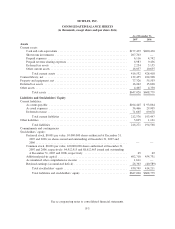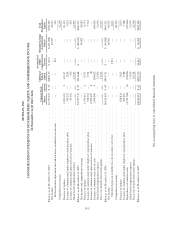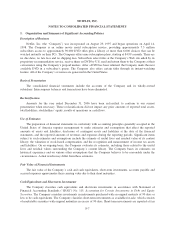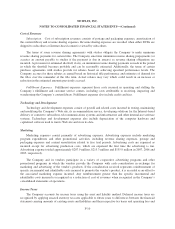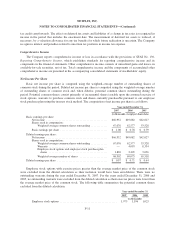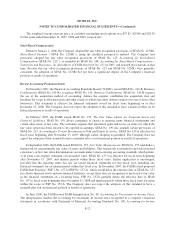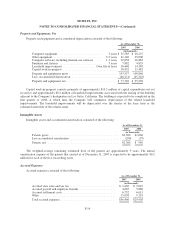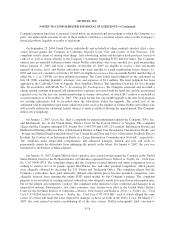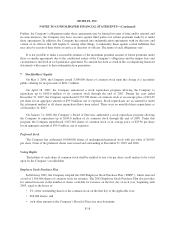NetFlix 2007 Annual Report Download - page 59
Download and view the complete annual report
Please find page 59 of the 2007 NetFlix annual report below. You can navigate through the pages in the report by either clicking on the pages listed below, or by using the keyword search tool below to find specific information within the annual report.NETFLIX, INC.
NOTES TO CONSOLIDATED FINANCIAL STATEMENTS—(Continued)
value with unrealized gains and losses included in accumulated other comprehensive income within
stockholders’ equity in the consolidated balance sheet. The amortization of premiums and discounts on the
investments, realized gains and losses, and declines in value judged to be other-than-temporary on
available-for-sale securities are included in interest and other income in the consolidated statements of
operations. The Company uses the specific identification method to determine cost in calculating realized gains
and losses upon the sale of short-term investments.
Short-term investments are reviewed periodically to identify possible other-than-temporary impairment.
When evaluating the investments, the Company reviews factors such as the length of time and extent to which
fair value has been below cost basis, the financial condition of the issuer and the Company’s ability and intent to
hold the investment for a period of time which may be sufficient for anticipated recovery in market value.
Restricted Cash
As of December 31, 2007 and 2006, other assets included restricted cash of $1.9 million and $1.5 million,
respectively, related to workers’ compensation insurance deposits. In addition, as of December 31, 2007 and
2006, other current assets included $2.3 million and $2.2 million, respectively, set aside for plaintiffs’ attorneys’
fees and expenses in the Chavez vs. Netflix, Inc. lawsuit. See Note 5 for further discussion.
Content Library
The Company acquires content from studios and distributors through direct purchases, revenue sharing
agreements or license agreements. The Company acquires content for the purpose of rental to its subscribers and
earns subscription rental revenues, and, as such, the Company considers its content library to be a productive
asset. Accordingly, the Company classifies its content library as a non-current asset on its consolidated balance
sheets. Additionally, in accordance with SFAS No. 95, Statement of Cash Flows, cash outflows for the
acquisition of the content library, net of changes in accounts payable, are classified as cash flows from investing
activities in the Company’s consolidated statements of cash flows. This is inclusive of any upfront
non-refundable payments required under revenue sharing agreements.
The Company amortizes its DVDs, less estimated salvage value, on a “sum-of-the-months” accelerated
basis over their estimated useful lives. The useful life of the new release DVDs and back catalog DVDs is
estimated to be 1 year and 3 years, respectively. In estimating the useful life of its DVDs, the Company takes into
account library utilization as well as an estimate for lost or damaged DVDs. Volume purchase discounts received
from studios on the purchase of titles are recorded as a reduction of DVD inventory when earned.
The Company provides a salvage value of $3.00 per DVD for those direct purchase DVDs that the Company
estimates it will sell at the end of their useful lives. For those DVDs that the Company does not expect to sell, no
salvage value is provided.
Under revenue sharing agreements with studios and distributors, the Company generally obtains titles for
low initial cost in exchange for a commitment to share a percentage of our subscription revenues or a fee, based
on utilization, over a fixed period, or the Title Term, which typically ranges from six to twelve months for each
DVD title. The revenue sharing expense associated with the use of each title is expensed to cost of revenues. At
the end of the Title Term, the Company generally has the option of returning the DVD title to the studio,
destroying the title or purchasing the title. In addition, the Company remits an upfront non-refundable payment to
acquire titles from the studios and distributors under revenue sharing agreements. This payment includes a
contractually specified initial fixed license fee that is capitalized and amortized in accordance with the
F-8







